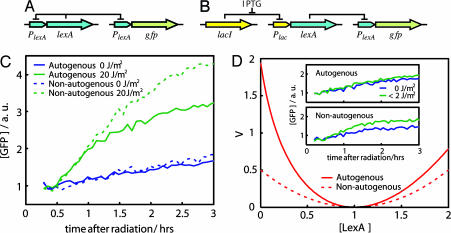Fig. 1.
Autogenous and nonautogenous control of LexA determines SOS response. (A) Wild-type LexA regulatory circuit plus GFP reporter. (B) Synthetic LexA regulatory circuit plus GFP reporter. (C) SOS dynamics (GFP fluorescence) after UV irradiation in cells with (solid line) or without (dashed line) autogenous regulation. GFP levels without radiation for both cases are shown in blue. (D) Stability potential, V (26, 27), associated with the uninduced LexA state (before UV radiation) for the autogenous (solid line) and nonautogenous (dashed line) circuits. LexA concentrations are in units of uninduced LexA equilibrium such that xeq = 1. (D Inset) SOS dynamics as in C for a very small UV dose (<2 J/m2) reveals the buffering effect of autogenous control. Reproducibility error of experiments performed on different days was ≈10%.

